A book authored by Chan Choenni & Kanta Adhin, on the history of 150 years of migration of Hindostanis (Indian) was laouched on Ist June 2024, at Den Haag, Netherlands.
The book was launched at the National Archives(National Archief) in the presence of Jan Zanen, the Mayor of Den Haag.
Other dignatories present at the launch were Rabin Baldewsingh (National Coordinator against Discrimination and Racism), Krish Gupta (director of The Gandhi Centre the Hague), Mrs. Padma Ratan-Jipat (well known active member of the Hindostani community in the Hague) and Arjan Agema (head of digitalization specialised on Suriname – National Archives).
Later on, 5th June Hindostani Immigration Day Hobbenmaplein, at the Immigration Moonument, the book was presented to presented to Minister Robbert Dijkgraaf (Education, Culture and Science) Ambassador of India, Mrs. Reenat Sandhu
Ambassador of Suriname, Mr. Rajendre Khargi.
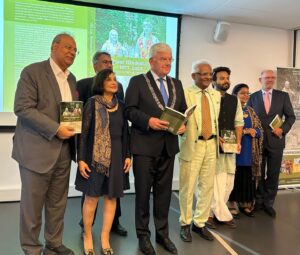
Synopsis of the Book:
Hindostani’s are the descendants of the indentured labourers who were brought to Suriname from then British India to work on the plantations after the abolition of slavery in 1863. This occurred on the basis of the 1870 agreement between the Netherlands and Britain ‘concerning the immigration of free workers from British India for the colony of Suriname’, known as the Immigration Treaty also or the Coolie Treaty. The first group of 410 indentured labourers arrived in Suriname on 5 June 1873 with the shop Lalla Rookh. This day is commemorated and celebrated annually as the Day of the Hindostani Immigration.
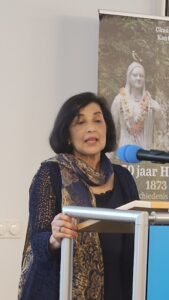
From 1873 to 1916, over 34,000 workers were brought to Suriname with a five-year contract, the so-called British-Indian immigrants who later called themselves Hindostani’s. After five years they could return to their home country, enter into a new five year contract or stay in Suriname as a free worker. The colonial government was very pleased with their work ethic and encouraged stay in Suriname. As a result, more than two-thirds settled in Suriname after the contract expired. They played a pivotal role in the agricultural economy of Suriname. As immigrants, they and their descendants experienced discrimination and exclusion that continued after they obtained Dutch citizenship in 1927. Even when they were the largest population in multi-ethnic Suriname around 1970 – with a share of about 37 per cent – they were politically excluded during the process towards independence of Suriname in 1975.
This led to a second migration out of fear of the uncertain future. Prior to independence, about 40,000 Hindostani’s arrived in the Netherlands, with smaller numbers thereafter. Today, the approximately 180,000 Hindostani’s make up about one per cent of the Dutch population and
are the largest group among the Surinamese population groups in the Netherlands. Still many Dutch people are not aware of the Surinamese background of the Hindostani people and their history. They are often directly associated with India.
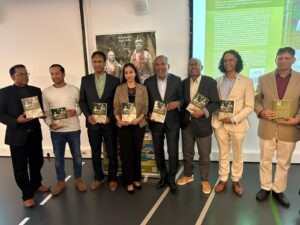
The book 150 Years of Hindostani’s 1873-2023 – A History of Two Migrations provides insight into indentured labour as a system of exploitation, but also of opportunities. The ancestors were not passive victims. They stood up for their rights, as evidenced by several uprisings, some of which ended in bloodshed. Besides, many also saw opportunities for a better life and took initiatives to improve their lot. The book further contains a historical and current overview of Hindostani’s in Suriname and in the Netherlands and their relations through time with India, the land of their ancestors. Topics covered include citizenship, integration, culture, religion, political participation, interrelationships and the (increasing) orientation towards India and the triangular relationship between the three countries. Personal stories and photographs contribute to a vivid picture.
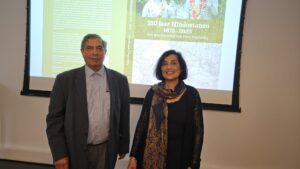 Surinder Gautama(editor Eshadoot) with Kanta Adhin at the Book Launch-Den Haag
Surinder Gautama(editor Eshadoot) with Kanta Adhin at the Book Launch-Den Haag
Currently, there is an ongoing debate in the Netherlands on colonial history which is dominated by slavery. With this book the authors draw attention to another part of the colonial history, that of indentured labour and developments after that. There are parallels in those in Suriname and in the Netherlands, such as a strong focus of Hindostani’s on socio-economic progress, preservation of their culture and their orientation towards India, with Bollywood as an important factor. But also, for example, preferring not to talk about problems. In the Netherlands, Hindostani’s are often seen as silent migrants.
In Suriname, they are still the largest group and currently, besides their dominant socio-economic position in the country, they also possess political power. In 2020 a Hindostani president was elected. On 5 June 2023, president Draupadi Murmu of India attended the 150th commemoration of Hindostani Immigration Day in Suriname. It was her first official visit to a foreign country after her inauguration in 2022.
The book, written in Dutch language is available via the webshop of the Publishers www,Sampreshan.com and all online bookstores.

Readers like you, make ESHADOOT work possible. We need your support to deliver quality and positive news about India and Indian diaspora - and to keep it open for everyone. Your support is essential to continue our efforts. Every contribution, however big or small, is so valuable for our future.

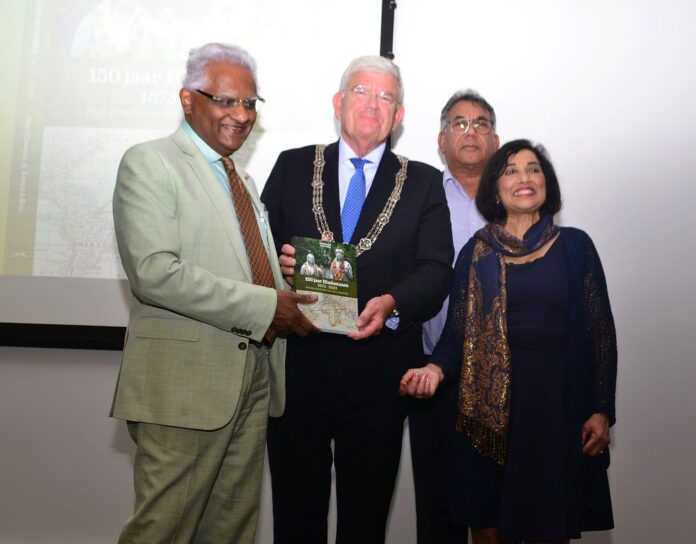




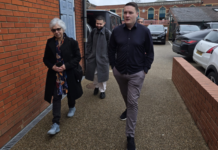





This is fascinating history and Surinam, once you find out about the history through such publications one realises how the British uses their colonial power to take vulnerable people from their birth place to a new country to work on sugar plantations. But they kept their Hindu tradition alive